As the global push towards clean energy intensifies, renewable energy projects are becoming more ambitious and widespread. Despite government support wavering in some regions, private companies are demonstrating resilience by adopting cutting-edge technology that streamlines construction processes. Among these innovations, robotics stand out as a transformative force, offering not only increased precision but also unparalleled efficiency. This technological evolution challenges traditional project methodologies, pushing the industry toward a future where human labor is complemented—and in some cases replaced—by autonomous systems that can operate in even the most demanding environments.
The focus on solar farm development exemplifies this shift. These projects require meticulous planning, extensive surveying, and precise layout marking, often involving long hours and significant manpower. Historically, such tasks relied heavily on manual surveyors, whose efforts could be hampered by rugged terrains, weather conditions, and logistical complexities. Yet, recent advancements reveal a radical departure from these manual processes, with robots like CivDot emerging as game changers in the field.
Robotics as a Game Changer in Terrain-Challenging Environments
CivDot, a four-wheeled surveying robot conceived by Civ Robotics, epitomizes this technological leap. Capable of marking thousands of layout points per day with an accuracy within mere millimeters, it is designed to withstand the rigors of outdoor and uneven terrains. Its ability to navigate rocky deserts, muddy grounds, and rugged landscapes represents a significant advantage over traditional surveying methods, which often require extensive manual effort and are vulnerable to environmental disruptions.
This robot’s core strength lies in its advanced navigation and geospatial capabilities. By uploading pre-existing data into its software, operators can designate specific areas for marking, after which CivDot autonomously carries out the task. This dramatically reduces the need for multiple human survey teams, cutting operational costs and accelerating project timelines—an essential benefit when scaling renewable infrastructure rapidly is paramount. The transition from manual labor to automation signifies a pivotal moment in project management, where time saved translates directly into cost efficiency, enabling faster project completion and earlier energy production.
The Impact on Industry Standards and Workforce Dynamics
The practical benefits extend beyond just speed. Bechtel, a global engineering giant, reports that using CivDot robots amplifies daily productivity from approximately 350 points to over 1,200. Such improvements in throughput are not trivial; they fundamentally alter the economics of project execution. Moreover, the ability to operate in challenging terrains—thick brush, muddy landscapes, or rocky deserts—means that projects can venture into previously inaccessible areas, expanding the geographical footprint of renewable energy initiatives.
However, this technological revolution raises questions about workforce dynamics. While some may worry about job displacement, the reality is more nuanced. Skilled surveyors and engineers are transitioned into roles that oversee, maintain, and optimize robotic systems. The human element remains vital, especially in complex decision-making and troubleshooting, but the nature of work is shifting toward higher-value tasks. Companies investing in robotics must also grapple with logistical challenges such as battery life and machine maintenance, but these are manageable with proper planning.
The backing of venture capital and strategic partnerships underscores confidence in this technology’s potential. Civ Robotics’ recent funding, bolstered by notable investors like FF Venture Capital and commercial entities such as Bobcat Company, signals that the industry sees autonomous robotics as a high-impact solution that can redefine project execution standards.
Looking Ahead: The Future of Construction in Renewable Energy
As robotic solutions like CivDot prove their worth, the renewable energy sector may evolve into an era where construction is largely autonomous. This trend isn’t merely about efficiency; it reflects a broader shift toward smarter, more sustainable development practices. With machine learning and advanced navigation systems continuing to improve, future robots could undertake even more complex tasks—such as real-time site assessments and adaptive planning—reducing reliance on human intervention further.
Notably, Civ Robotics’ focus on rugged terrains gives it an edge over competitors whose solutions are primarily designed for smoother surfaces like roads or sports fields. This specialization positions autonomous surveyors as essential tools for the expanding global footprint of solar farms and wind turbines, especially in remote or challenging environments. As the industry matures, such technologies are not just innovations but necessities for meeting ambitious energy goals within tight timelines.
By embracing robotics, the renewable energy sector is not simply adopting new tools—it is fundamentally transforming how projects are conceived, constructed, and managed. This revolution promises faster deployment, lower costs, and broader access to clean energy, ultimately accelerating the transition to a sustainable future. As companies continue to innovate, one thing is clear: autonomous systems will be at the core of building tomorrow’s energy infrastructure.

